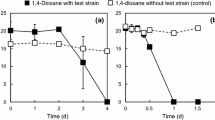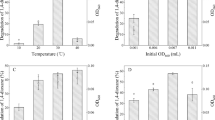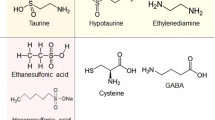Abstract
Rhodococcus aetherivorans JCM 14343 can degrade 1,4-dioxane as a sole carbon and energy source. This study aimed to characterize this 1,4-dioxane degradation ability further, and assess the potential use of the strain for 1,4-dioxane removal in industrial wastewater. Strain JCM 14343 was able to degrade 1,4-dioxane inducibly, and its 1,4-dioxane degradation was also induced by tetrahydrofuran and 1,4-butanediol. The demonstration that 1,4-butanediol not only induced but also enhanced 1,4-dioxane degradation was a novel finding of this study. Although strain JCM 14343 appeared not to be an effective 1,4-dioxane degrader considering the maximum specific 1,4-dioxane degradation rate (0.0073 mg-dioxane/mg-protein/h), half saturation concentration (59.2 mg/L), and cell yield (0.031 mg-protein/mg-1,4-dioxane), the strain could degrade over 1100 mg/L of 1,4-dioxane and maintain its degradation activity at a wide range of temperature (5–40 °C) and pH (4–9) conditions. This suggests the usefulness of strain JCM 14343 in 1,4-dioxane treatment under acidic and cold conditions. In addition, 1,4-dioxane degradation experiments in the presence of ethylene glycol (EG) or other cyclic ethers revealed that 1,4-dioxane degradation by strain JCM 14343 was inhibited in the presence of other cyclic ethers, but not by EG, suggesting certain applicability of strain JCM 14343 for industrial wastewater treatment.







Similar content being viewed by others
References
Adams CD, Scanlan PA, Secrist ND (1994) Oxidation and biodegradability enhancement of 1,4-dioxane using hydrogen peroxide and ozone. Environ Sci Technol 28:1812–1818
Agency for Toxic Substances and Disease Registry (2012) Toxicological profile for 1,4-dioxane. United States Department of Health and Human Services, Public Health Service, Atlanta, GA
Bernhardt D, Diekmann H (1991) Degradation of dioxane, tetrahydrofuran and other cyclic ethers by an environmental Rhodococcus strain. Appl Microbiol Biotechnol 36:120–123
Bock C, Kroppenstedt RM, Diekmann H (1996) Degradation and bioconversion of aliphatic and aromatic hydrocarbons by Rhodococcus ruber 219. Appl Microbiol Biotechnol 45:408–410
Chen DZ, Jin XJ, Chen J, Ye JX, Jiang NX, Chen JM (2016) Intermediates and substrate interaction of 1,4-dioxane degradation by the effective metabolizer Xanthobacter flavus DT8. Int Biodeterior Biodegrad 106:133–140
Deng D, Li F, Li M (2018) A novel propane monooxygenase initiating degradation of 1,4-dioxane by Mycobacterium dioxanotrophicus PH-06. Environ Sci Technol Lett 5:86–91
Goodfellow M, Jones AL, Maldonado LA, Salanitro J (2004) Rhodococcus aetherivorans sp. nov., a new species that contains methyl t-butyl ether-degrading actinomycetes. Syst Appl Microbiol 27:61–65
Grostern A, Sales CM, Zhuang W-Q, Erbilgin O, Alvarez-Cohen L (2012) Glyoxylate metabolism is a key feature of the metabolic degradation of 1,4-dioxane by Pseudonocardia dioxanivorans strain CB1190. Appl Environ Microbiol 78:3298–3308
Hand S, Wang B, Chu KH (2015) Biodegradation of 1,4-dioxane: effects of enzyme inducers and trichloroethylene. Sci Total Environ 520:154–159
He Y, Mathieu J, Yang Y, Yu P, da Silva MLB, Alvarez PJJ (2017) 1,4-Dioxane biodegradation by Mycobacterium dioxanotrophicus PH-06 is associated with a group-6 soluble di-iron monooxygenase. Environ Sci Technol Lett 4:494–499
Huang H, Shen D, Li N, Shan D, Shentu J, Zhou YY (2014) Biodegradation of 1,4-dioxane by a novel strain and its biodegradation pathway. Water Air Soil Pollut 225:2135
Inoue D, Tsunoda T, Sawada K, Yamamoto N, Saito Y, Sei K, Ike M (2016) 1,4-Dioxane degradation potential of members of the genera Pseudonocardia and Rhodococcus. Biodegradation 27:277–286
International Agency for Research on Cancer (IARC) (1999) 1,4-Dioxane. In: IARC monographs on the evaluation of carcinogenic risks to humans, vol. 71, Re-evaluation of some organic chemicals, hydrazine and hydrogen peroxide. IARC, Lyon, pp 589–602
Isaka K, Udagawa M, Kimura Y, Sei K, Ike M (2016a) Biological wastewater treatment of 1,4-dioxane using polyethylene glycol gel carriers entrapping Afipia sp. D1. J Biosci Bioeng 121:203–208
Isaka K, Udagawa M, Kimura Y, Sei K, Ike M (2016b) Biological 1,4-dioxane wastewater treatment by immobilized Pseudonocardia sp. D17 on lower 1,4-dioxane concentration. J Water Environ Technol 14:289–301
Isaka K, Udagawa M, Sei K, Ike M (2016c) Pilot test of biological removal of 1,4-dioxane from a chemical factory wastewater by gel carrier entrapping Afipia sp. strain D1. J Hazard Mater 304:251–258
Kämpfer P, Kroppenstedt RM (2004) Pseudonocardia benzenivorans sp. nov. Int J Syst Evol Microbiol 54:749–751
Kim YM, Jeon JR, Murugesan K, Kim EJ, Chang YS (2009) Biodegradation of 1,4-dioxane and transformation of related cyclic compounds by a newly isolated Mycobacterium sp. PH-06. Biodegradation 20:511–519
Li M, Fiorenza S, Chatham JR, Mahendra S, Alvarez PJJ (2010) 1,4-Dioxane biodegradation at low temperatures in Arctic groundwater samples. Water Res 44:2894–2900
Li M, Mathieu J, Yang Y, Fiorenza S, Deng Y, He Z, Zhou J, Alvarez PJJ (2013) Widespread distribution of soluble di-iron monooxygenase (SDIMO) genes in Arctic groundwater impacted by 1,4-dioxane. Environ Sci Technol 47:9950–9958
Li M, Liu Y, He Y, Mathieu J, Hatton J, DiGuiseppi W, Alvarez PJJ (2017) Hindrance of 1,4-dioxane biodegradation in microcosms biostimulated with inducing or non-inducing auxiliary substrates. Water Res 112:217–225
Li M, Yang Y, He Y, Mathieu J, Yu C, Li Q, Alvarez PJJ (2018) Detection and cell sorting of Pseudonocardia species by fluorescence in situ hybridization and flow cytometry using 16S rRNA-targeted oligonucleotide probes. Appl Microbiol Biotechnol 102:3375–3386
Mahendra S, Alvarez-Cohen L (2006) Kinetics of 1,4-dioxane biodegradation by monooxygenase-expressing bacteria. Environ Sci Technol 40:5435–5442
Masuda H, McClay K, Steffan RJ, Zylstra GJ (2012) Biodegradation of tetrahydrofuran and 1,4-dioxane by soluble diiron monooxygenase in Pseudonocardia sp. strain ENV478. J Mol Microbiol Biotechnol 22:312–316
Matsui R, Takagi K, Sakakibara F, Abe T, Shiiba K (2016) Identification and characterization of 1,4-dioxane-degrading microbe separated from surface seawater by the seawater-charcoal perfusion apparatus. Biodegradation 27:155–163
Parales RE, Adamus JE, White N, May HD (1994) Degradation of 1,4-dioxane by an actinomycete in pure culture. Appl Environ Microbiol 60:4527–4530
Prabahar V, Dube S, Reddy GSN, Shivaji S (2004) Pseudonocardia antarctica sp. nov. an Actinomycetes from McMurdo Dry Valleys, Antarctica. Syst Appl Microbiol 27:66–71
Sales CM, Grostern A, Parales JV, Parales RE, Alvarez-Cohen L (2013) Oxidation of the cyclic ethers 1,4-dioxane and tetrahydrofuran by a monooxygenase in two Pseudonocardia species. Appl Environ Microbiol 79:7702–7708
Sei K, Miyagaki K, Kakinoki T, Fukugasako K, Inoue D, Ike M (2013a) Isolation and characterization of bacterial strains that have high ability to degrade 1,4-dioxane as a sole carbon and energy source. Biodegradation 24:665–674
Sei K, Oyama M, Kakinoki T, Inoue D, Ike M (2013b) Isolation and characterization of tetrahydrofuran-degrading bacteria for 1,4-dioxane-containing wastewater treatment by co-metabolic degradation. J Water Environ Technol 11:11–19
Skinner K, Cuiffetti L, Hyman M (2009) Metabolism and cometabolism of cyclic ethers by a filamentous fungus, a Graphium sp. Appl Environ Microbiol 75:5514–5522
Stepien DK, Diehl P, Helm J, Thoms A, Püttmann W (2014) Fate of 1,4-dioxane in the aquatic environment: from sewage to drinking water. Water Res 48:406–419
Vainberg S, McClay K, Masuda H, Root D, Condee C, Zylstra GJ, Steffan RJ (2006) Biodegradation of ether pollutants by Pseudonocardia sp. strain ENV478. Appl Environ Microbiol 72:5218–5224
Wolfe NL, Jeffers PM (2000) Hydrolysis. In: Boethlig RS, Mackay D (eds) Handbook of property estimation methods for chemicals: environmental and health sciences. Lewis Publishers, Chelsea, pp 311–334
Yamamoto N, Inoue D, Kuroda M, Taki H, Sei K, Saito Y, Ike M (2018a) Development of practical treatment system for 1,4-dioxane-containing industrial wastewater using Pseudonocardia sp. N23. J Water Waste 60:139–150 (in Japanese)
Yamamoto N, Saito Y, Inoue D, Sei K, Ike M (2018b) Characterization of newly isolated Pseudonocardia sp. N23 with high 1,4-dioxane-degrading ability. J Biosci Bioeng (in press)
Zhang S, Gedalanga PB, Mahendra S (2017) Advances in bioremediation of 1,4-dioxane-contaminated waters. J Environ Manag 204:765–774
Acknowledgements
This study was supported by the Adaptable and Seamless Technology Transfer Program through Target-driven R&D (A-STEP) (Grant Number AS2715159U) of the Japan Science and Technology Agency (JST), and by the Kurita Water and Environment Foundation (Grant Number 16K024).
Author information
Authors and Affiliations
Corresponding author
Ethics declarations
Conflict of interest
The authors declare that they have no conflict of interest.
Electronic supplementary material
Below is the link to the electronic supplementary material.
Rights and permissions
About this article
Cite this article
Inoue, D., Tsunoda, T., Yamamoto, N. et al. 1,4-Dioxane degradation characteristics of Rhodococcus aetherivorans JCM 14343. Biodegradation 29, 301–310 (2018). https://doi.org/10.1007/s10532-018-9832-2
Received:
Accepted:
Published:
Issue Date:
DOI: https://doi.org/10.1007/s10532-018-9832-2




